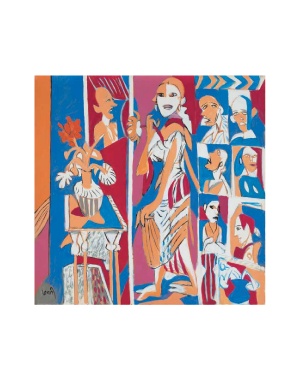Page 221 - Iconic Masters October2023
P. 221
Lot No. 182
K G SUBRAMANYAN
1924-2016
THE TAPESTRY
30 x 30 in (76.2 x 76.2 cm)
Acrylic on canvas
2007
` 15,00,000 - 20,00,000 | $ 17,647 - 23,529
Exhibited: ‘The Magic of Making: An exhibition
of paintings by K. G. Subramanyan’ at Seagull
Foundation of Art, December 2007 - April 2003.
Published: The Magic of Making: An exhibition
of paintings by K. G. Subramanyan’ by Seagull
Foundation of Art, pg. 45.
Art & Deal Magazine, Volume 10, Issue 68, pg. 18.
Provenance: Property from a collection based in
New Delhi. The artwork was originally acquired from Covers of the publications with the work illustrated.
Seagull Foundation.
Born in 1924 in Kuthuparamba, Kannur, Kerala, K.G.
Subramanyan was a multifaceted talent, excelling as
an artist, writer, art teacher, and historian. Raised in
a Tamil family with a deep appreciation for Carnatic
music, harikatha performances, and theatrical
plays, his formative years were enriched by these
cultural influences. The grandeur of temples and the
expressive artistry of ritual dance performances left
an indelible mark on his creative spirit. Subramanyan’s
fascination with the nationalist movement and its post-
Independence implications became a central theme in
his artistic exploration. K.G. Subramanyan’s art draws richly from Indian
mythology, folklore, and traditional folk art, with a
Although he earned a Bachelor’s Degree in Economics particular emphasis on Bengali art forms such as
from Presidency College, Chennai, his heart belonged Kalighat paintings. Initially, his creations centred around
to the arts. In 1944, he followed his passion to figurative subjects, including women, children, and
Santiniketan, where he was mentored by renowned animals. As his career evolved, he ventured into still-
artists like Nandalal Bose, Benode Behari Mukherjee, life compositions, exploring the object as a form, and
and Ramkinkar Baij. Their profound influences are also embarked on his intriguing terrace series. His works
discernible in his works from the 1950s. He furthered are characterised by vibrant colours, bold black lines,
his artistic education at the Slade School of Art, and abstract elements, all intertwined with a deep
University of London, supported by a British Council reverence for Indian tradition. This distinctive blend
Research Fellowship. results in a truly unique visual language.

